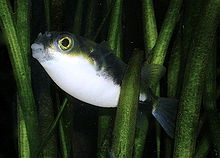- Colomesus
-
Colomesus 
South American freshwater puffer
(Colomesus asellus)Scientific classification Kingdom: Animalia Phylum: Chordata Subphylum: Vertebrata Class: Actinopterygii Order: Tetraodontiformes Family: Tetraodontidae Genus: Colomesus
Gill, 1884Species - South American freshwater puffer, Colomesus asellus
- Banded puffer or parrot puffer, Colomesus psittacus
The genus Colomesus includes two species of pufferfish confined to tropical South America. Apart from differences in size, the two species are superficially similar, being green above, white below, and patterned with black transverse bands across the dorsal surface.[1]
Contents
Taxonomy
- The type species, Colomesus psittacus, is a euryhaline species that moves freely between freshwater and the sea. Colomesus psittacus is the larger of the two species, reaching around 30 centimetres (12 in) long when mature.[2]
- The second species, Colomesus asellus, is normally only found in freshwater environments although it will tolerate slightly brackish water.[2][3] Colomesus asellus is relatively small, with most specimens being around 8 cm (3.1 in) when mature though specimens up to 15 cm (5.9 in) have been reported.[1] Compared with Colomesus psittacus, the black bands on the back are much thicker, and it also has a distinctive black band that rings the base of the caudal fin.[1]
Common names
- Common names used for Colomesus psittacus include parrot puffer[1] and South American estuarine puffer.[2]
- Colomesus asellus is known as the asell puffer[1], South American freshwater puffer[2] and Peruvian puffer.[4]
Ecology
Wild Colomesus asellus are reported to consume benthic crustaceans, fish, planktonic invertebrates, and plants.[3] Aquarium specimens consume various invertebrates including midge larvae[1] and mysids.[2] The natural diet of Colomesus psittacus is carnivorous and consists mainly of molluscs.[5] In the aquarium they eat a variety of invertebrates including snails, clams and shrimps.[2]
Like other pufferfish, they have the ability to inflate themselves when threatened, making themselves much larger and therefore more difficult for predators to handle or swallow. Colomesus asellus is unusual among freshwater pufferfish for being migratory[6] and non-territorial.[1]
Colomesus asellus is known to breed during the wet season, spawning in rivers, with the numerous small eggs being scattered on the substrate and the larvae drifting downstream.[6]
Distribution
Colomesus psittacus is found all along the Western Atlantic coastline of South America from the Gulf of Paria down to the mouth of the Amazon River in Brazil. Colomesus asellus is confined to the Amazon River basin from Brazil as far west as Peru.[1]
Toxicity
Colomesus asellus is known to contain the toxin saxitoxin. Colomesus psittacus is known to have edible flesh but a toxic liver but whether it contains saxitoxin or tetrodotoxin (as is the case with many marine puffers) is not known.[7]
Colomesus spp. in aquaria
Colomesus asellus is fairly widely kept as an aquarium fish.[1] It needs plenty of swimming space and strong water current. Compared to other freshwater pufferfish, Colomesus asellus is unusual in being tolerant of conspecifics tends to be nervous when kept singly.[8] It may be kept in community tanks, but it is a fin-nipper and will attack slow moving species such as angelfish, guppies, and Corydoras.
Because of its large size and need for salt water, Colomesus psittacus is rarely kept in home aquaria, but it is otherwise similar Colomesus asellus in terms of maintenance.[9] It is not a schooling species and may be aggressive towards others of its species, so is usually kept alone.[5]
References
- ^ a b c d e f g h i Ebert, Klaus (2001). The Puffers of Fresh and Brackish Water. Aqualog. ISBN 393170260X.
- ^ a b c d e f Monks, N., ed (2006). Brackish Water Fishes. TFH. ISBN 0-7938-0564-3.
- ^ a b Froese, Rainer, and Daniel Pauly, eds. (2008). "Colomesus asellus" in FishBase. August 2008 version.
- ^ Ralph, Chris (2003). Pufferfish. Ringpress Books. ISBN 1860542336.
- ^ a b Froese, Rainer, and Daniel Pauly, eds. (2008). "Colomesus psittacus" in FishBase. August 2008 version.
- ^ a b Carlos Araujo-Lima, Daniela Savastano, & Luciana Cardeliquio Jordao (1994). "Drift of Colomesus asellus (Teleostei: Tetraodontidae) larvae in the Amazon River" (PDF). Revue d’Hydrobiologie Tropicale 27: 33–38. http://www.bondy.ird.fr/pleins_textes/cahiers/hydrob-trop/43866.pdf.
- ^ J. C. Freitas (2006). "Eating habits: are we safe to consume freshwater puffer fish from the Amazon region in Brazil?" (PDF). Journal of Venomous Animals and Toxins including Tropical Diseases 12: 153–155. http://www.scielo.br/pdf/jvatitd/v12n2/v12n2a01.pdf.
- ^ "Colomesus asellus". http://www.thepufferforum.com/forum/ug.php/v/PufferPedia/Freshwater/C_Asellus/. Retrieved February 16, 2007.
- ^ "Colomesus psittacus". http://www.thepufferforum.com/forum/ug.php/v/PufferPedia/Brackish/C_Psittacus/. Retrieved February 16, 2007.
External links
Categories:
Wikimedia Foundation. 2010.
